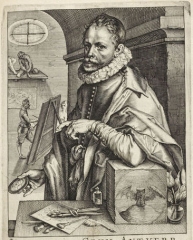Details
Banquet of the Gods at the wedding of Peleus and Thetis [Catullus, Carmina, 64];
The guests sit at a long table in the clouds and include Jupiter (with his eagle at his feet) and Juno (accompanied by her peacock), Venus and Cupid, Bacchus, Mercury (at r), Hercules (at left) among others. 1589
Engraving
Lettered in lower left corner in a box "CVBroeck. Inuent. Ao 1589 / DGheyn. sculptor / J.Razet exc:". In the margin three columns of text, each two lines "Dum conuiuatum ... trakens" by "H.I.R" (Heyman Jacobi).
Published by Jacques Razt (Active 1589-1609 died)
Amsterdam art collector, dedicatee of part of van Mander's biographies, amateur calligrapher. Publisher as amateur of c.30 prints. He left his estate to foster art of painting and engracing, his lates passed to Robert de Baudous.
Additional Information
| SKU | xxaa44 |
|---|---|
| Picture Size | 33 x 48 cm |
| Specification | |
| technic | Engraving |
| Artist | Jacob de Gheyn II |
| period | 16th Century |
| School | Dutch |
| subject | Mythology |
| rating | **** |
Jacob de Gheyn II (1565 -1629)
 Dutch painter and engraver, whose work shows the transition from Northern Mannerism to Dutch realism over the course of his career.(also Jacques de Gheyn II) De Gheyn was born in Antwerp and received his first training from his father, Jacob de Gheyn I, a glass painter, engraver, and draftsman.In 1585, he moved to Haarlem, where he studied under Hendrik Goltzius for the next five years. He moved again, to Leiden, in the middle of the 1590s.
Dutch painter and engraver, whose work shows the transition from Northern Mannerism to Dutch realism over the course of his career.(also Jacques de Gheyn II) De Gheyn was born in Antwerp and received his first training from his father, Jacob de Gheyn I, a glass painter, engraver, and draftsman.In 1585, he moved to Haarlem, where he studied under Hendrik Goltzius for the next five years. He moved again, to Leiden, in the middle of the 1590s.
His work attracted the attention of wealthy sponsors, and his first commission was for an engraving of the Siege of Geertruidenberg from Maurice of Nassau, Prince of Orange. This event from March 27 to June 24, 1593, had been more of a demonstration of power by Prince Maurits, than an actual war, and had even attracted tourists. As a publicity stunt, the siege and its subsequent engraving were successful in propagating an image of Prince Maurits as an able general.
Around 1600, de Gheyn abandoned engraving, and focused on painting and etching. Moving to The Hague in 1605, he was employed often by Dutch royalty, designing a garden in the Buitenhof for Prince Maurice of Orange which featured the two first grottoes in the Netherlands. After Prince Maurice's death in 1625, de Gheyn worked for his brother, Prince Frederick Henry. De Gheyn painted some of the earliest female nudes, vanitas, and floral still lifes in Dutch art. He is credited with creating over 1,500 drawings, including landscapes and natural history illustrations.
He produced 117 engravings for the military manual The Exercise of Armes while living in Amsterdam. De Gheyn married Eva Stalpaert van der Wiele of Mechelen in 1595.
His son, Jacob de Gheyn III, was born in 1596, and grew to become an engraver in his own right, as well as the subject of a portrait by Rembrandt. De Gheyn died in The Hague.
All the items are guaranteed to be originals and as described.
A letter of authenticity is added by simple request.
Items may be returned within 15 days after arrival.
I ship worldwide and provide Insurance and other delivery options.
All items can be purchased instantly at the listed prices,
on reservation of errors in price or availibility..






 Facebook
Facebook Twitter
Twitter Subscribe us
Subscribe us Flickr
Flickr




